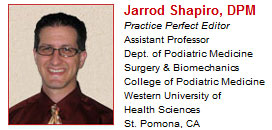|
I chose to be a podiatric physician. I spent years of my life working to attain an advanced degree, spent more time in residency, and then began working. Others have chosen different life paths, of course. The question, though, is why chose your particular path?
Some time ago I was talking with a physician colleague who argued her motivation was for money. She related that her goal was to make as much money as possible. She measured her level of success off of how many material objects she was able to acquire. Is money a legitimate motivator?
| FEATURED LECTURE |
| Today's Featured Lecture "Complex Limb Salvage: A New Perspective on Grafting" by David Pougatsh, DPM appears at the conclusion of the article. |
To some extent, we are all motivated by the desire to make money. Each of us reasonably wants a nice house, a car, clothes, various diversions in our off time, etc. What we’re really talking about here is economic security. How much “security” we have is a personal opinion. I wouldn’t mind being mega-rich (one of the one percenters), but that is not a motivating factor in my life. When it comes to money, my motivation for it ends after being economically secure, comfortable, and able to provide for my family (and maybe have a few luxuries).
The problem with using money as a motivator is twofold. First, once you’ve achieved that large amount of income you had been working toward, then theoretically you no longer have any other motivation to work. Second, the pursuit of wealth is actually a bottomless pit in which the pursuer can never truly reach their goal (unless you’re the richest person in the world and maybe not even then).
Take a look at the figure below, which describes Maslow’s hierarchy of needs.1 Maslow described this relationship of human motivation in 1943, which is very well known today.2 Economic security, which covers survival needs at its most basic level, leads one only to the second level of his hierarchy. It seems there is so much more than simple greed.
If not money, then what is an effective motivator? I often wonder about this topic when I review applicant files to the podiatry college and the residency program. When I see a virtually empty residency application file, I ask, “What was this person thinking, doing nothing during his four years in school other than taking classes?” If you think about it from a purely utilitarian approach, the purpose of podiatry school is to get into the best residency possible, so as to have the best chance to obtain a successful job. If this were truly the thought process, the applicant would have done everything possible to demonstrate leadership experience, research, community involvement, and a pursuit of knowledge above the level of one’s peers, in addition to strong clinical acumen. What could explain the empty application phenomenon? If logic doesn’t play a role, then it must be an emotional component (for example, laziness or fear).
Could emotional or behavior issues be the true motivator? |

